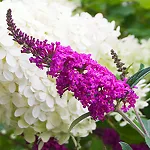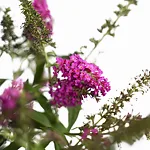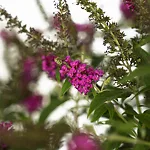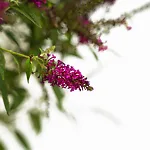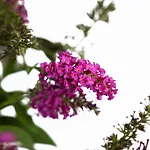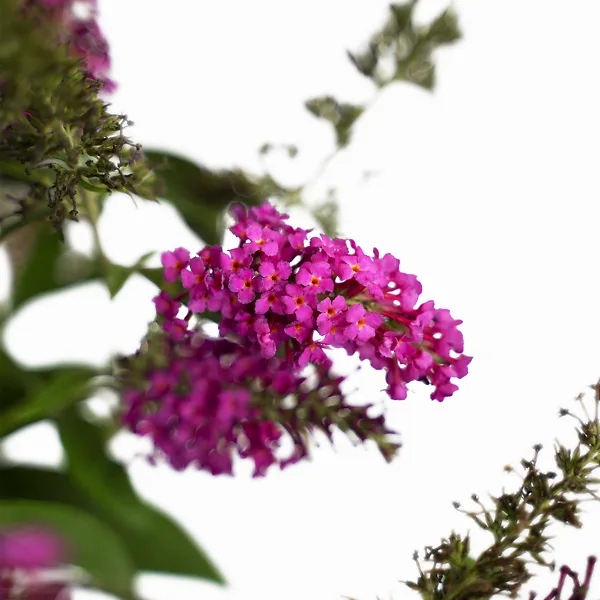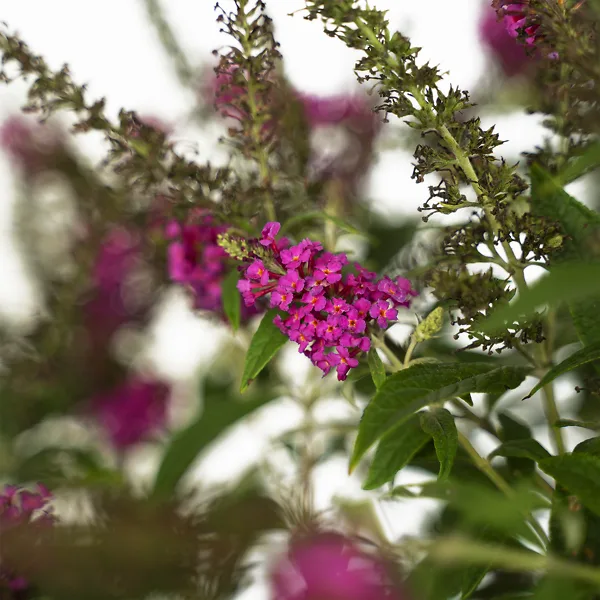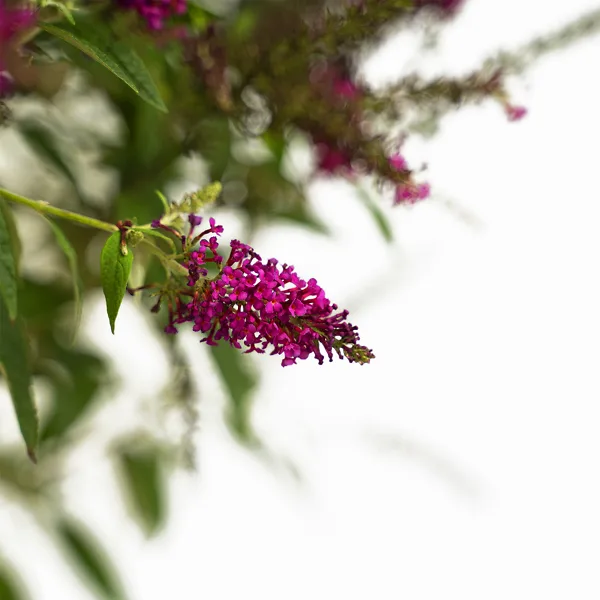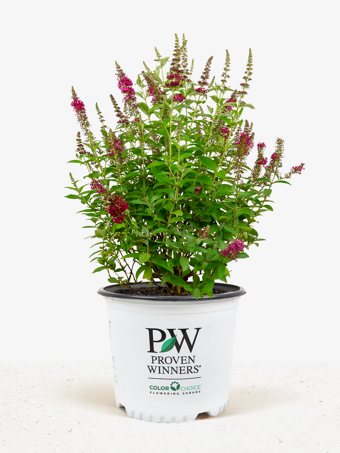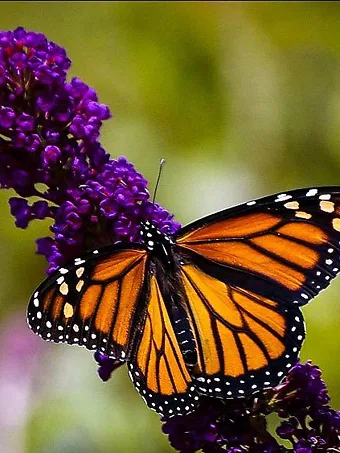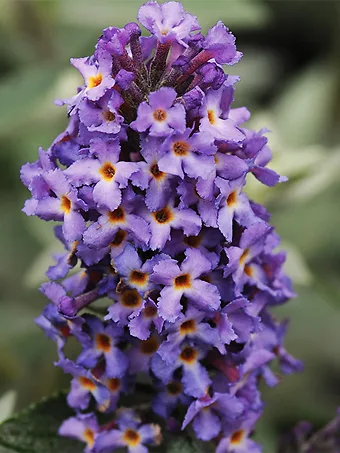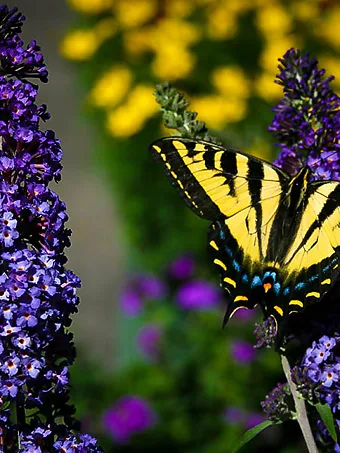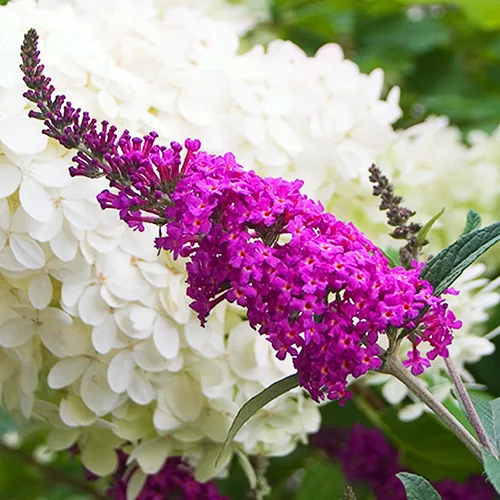
Miss Ruby Butterfly Bush
Buddleia ‘Miss Ruby’ (PP# 19,950)View more from Butterfly Bush
Miss Ruby Butterfly Bush
Buddleia ‘Miss Ruby’ (PP# 19,950)
30 day - ARRIVE AND THRIVE™ guaranteeLearn more


Special Features

Botanical Name
Buddleia ‘Miss Ruby’ (PP# 19,950)
Outdoor Growing zone
5-9
Mature Height
4-5
Mature Width
4-5
Sun needs
Full Sun, Partial Sun
The Miss Ruby Butterfly Bush is a new, non-invasive variety of this popular garden plant. It grows as a dense mound of arching branches, with long, tapering grey-green leaves. It will bloom non-stop from mid-summer to late fall. The flowers are bright purple-red, in spikes about 4 inches long. This is a very easy plant to grow in a sunny location in well-drained soil, and it grows no more than 5 feet tall, and the same across. Many different varieties of butterflies will come to your garden, as well as hummingbirds, all attracted to the nectar the flowers produce. Children love to watch the butterflies, making is an ideal plant for a children’s garden. It can also be planted among other flowering shrubs, or among annual and perennial flowers. It will grow well in tubs and pots, bringing color to your patio, and it really doesn’t need much care, being drought resistant once established, and free of pests or diseases.
- Bright, purple-red spikes of tiny blossoms
- A magnet for butterflies and humming birds
- Blooms continuously mid-summer through fall
- Medium-sized arching shrub reaching 5 feet
- Very easy plant for beginners and children to grow
Choose a sunny spot in well-drained soil for your Miss Ruby Butterfly Bush. It is hardy to zone 5 and grows well in dry soils, especially in the colder areas. Flowers can be trimmed once they fade, but this is not really necessary, as they do not produce seed. Spring pruning is desirable, and this is the only care needed by this tough plant. In colder areas it may die back to the ground in winter, but don’t worry, it will quickly re-sprout and be blooming away by mid-summer, brightening your summer garden, and continuing right up until the first frost.
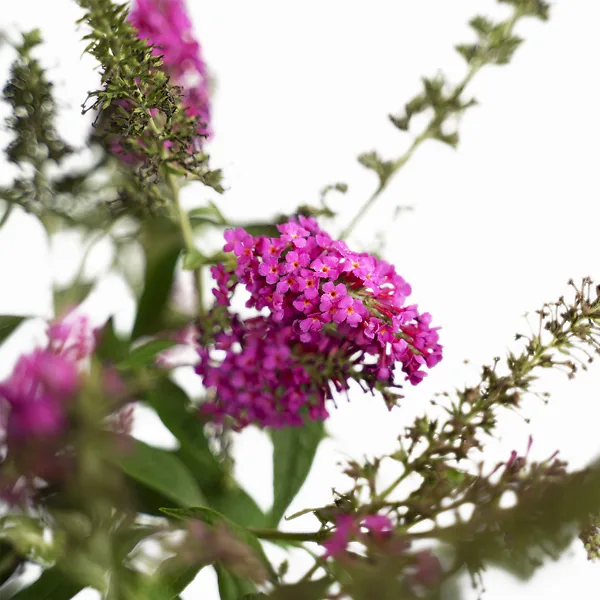
The butterfly bush seemed a few years ago to be an ‘endangered species’ in gardens, which would have been a great loss, since this easy-care plant is always a favorite. With its strong, bright colors, sweet fragrance and hordes of butterfly and humming bird friends, it is always a joy to grow. What was the problem? With our rising concern for the environment, we saw that it was spreading into wild areas, interfering with native plants. Many people stopped growing it, and two states banned its sale.
Fortunately, gardeners don’t give up, and plant breeders saw the need for new varieties that could not spread, so they set to work. The Miss Ruby Butterfly Bush is one of the most attractive results of that work. It is also a new, smaller form that fits much better into small gardens than older varieties did. Miss Ruby comes with ruby-red flowers in her hair, set off by soft grey-green leaves – and she stays where we put her, never seeding and spreading into surrounding wild areas. She grows a compact 4 to 5 feet tall, and spreads about the same distance across. She has lots of branches, so carries lots of flowers continuously from mid-summer right to the very end of fall, when the frost finally finishes her flowering.
The Miss Ruby Butterfly Bush can be sold in the states of Washington and Oregon, under the name ‘Summer Lilac’, because it has been studied and approved by those states. If you live there, and miss this lovely plant in your garden – its back again.
Growing Miss Ruby Butterfly Bushes
The Miss Ruby Butterfly Bush is more compact and more densely branched than older varieties, staying below 5 feet tall, so you get a lot more flowers in a smaller space. The long, tapering leaves are in pairs along the stems, and they are a handsome grey-green color. The flowers are small, but they are showy because they are clustered in long, tapering spikes, that are over 4 inches long and over an inch thick. Each head of flowers contains about 160 of the tiny flowers, which are a vibrant red-purple color, and scented. Flower spikes grow from the ends of every branch, and new side branches are formed along the stems to bring more flowers, after the end one has faded.
Appearance
Flower spikes are produced continuously from mid-summer until frost, and although you can trim off dead ones if you wish, because they do not make seed they quickly shrivel and disappear, their presence doesn’t reduce further flowering. This plant is genuinely continuous-blooming, bringing constant flower to your garden. It will first flower in mid-summer, and then keep going all the way into fall. With this bush you get months of flower in your garden.
Pruning
Some simple spring pruning will help produce the most flowers. When your plant begins to sprout, cut back any parts that have not sprouted, to buds that are sprouting. Remove thin shoots, leaving a framework of short, sturdy branches. In zones 5 and 6 plants may die back to the ground. They will re-sprout and bloom as expected, because blooms form on new shoots.
Planting Location
The Miss Ruby Butterfly Bush should be planted in a sunny place with at least 6 hours a day of direct sunlight, and preferably more. It grows best in a well-drained soil, which does not hold water, especially in winter, and not in low-lying places. There are many different uses for the Miss Ruby Butterfly Bush in your garden. Plant it among other sun-loving shrubs, to create a colorful border of mixed shrubs. Plant it right in among your annual and perennial flowers, for late blooms in a flower border. Where your children play is a wonderful place to plant one or two. Children love the kaleidoscope of butterfly visitors, and humming birds too. Grow it in a large pot, perhaps with some annual flowers around it, as a great feature on your terrace or patio. Whatever you do, you will love this plant.
History and Origins of the Miss Ruby Butterfly Bush
The butterfly bush (Buddleja davidii) grows wild in China, where plants can reach 15 feet in height. The plant was first found in 1869 by a French missionary and naturalist called Pere Armand David, when he was exploring the border between China and Tibet. In Europe and America it has been bred and changed into many different varieties, using other species too, so today’s plants are almost all hybrids. Following problems with butterfly bush spreading, plant breeders started developing sterile plants that would not produce seeds. Two professors of horticulture at North Carolina State University, Dennis J. Werner and Layne Snelling, took on this task. ‘Miss Ruby’ was produced by crossing two other varieties of Buddleja. One is called ‘Attraction’ and the other, ‘White Ball’. The second one was bred in the Netherlands in 1974, and the first is a product of Michael A. Dirr, another well-known breeder. ‘Miss Ruby’ was patented and released in 2009.
Buying Miss Ruby Butterfly Bushes at The Tree Center
The butterfly bush is a great favorite of gardeners, for its scent of honey, the gorgeous flowers and of course for the butterflies and humming birds it brings to your garden. We have a good stock of this plant, but demand for these new, non-invasive plants is high, so order now while stocks last. If you enjoy this plant, we encourage you to check out other varieties from this series like the Miss Molly Butterfly Bush.
